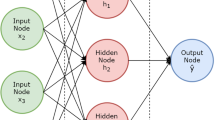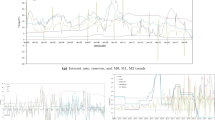Abstract
Artificial intelligence has shortened edges in many areas, especially the economy, to support long-term and accurate forecasting of financial indicators. Traditional statistical methods perform poorly compared to those based on artificial intelligence, which can achieve higher rates even with high-dimensional datasets. This method still needs evolution and studies. In emerging countries, decision-makers and investors must follow the basic interest rate, such as in Brazil, with a Special System of Settlement and Custody (Selic). Prior works used deep neural networks (DNNs) for forecasting time series economic indicators such as interest rates, inflation, and the stock market. However, there is no empirical evaluation of the prediction models for the Selic interest rate, especially the impact of training time and the optimization of hyperparameters. In this paper, we shed light on these issues and evaluate, through a fair comparison, the use of DNNs models for Selic time series forecasting. Our results demonstrate the potential of DNNs with an error rate above 0.00219 and training time above 84.28 s. Our findings open up opportunities for further investigations toward real-time interest rate forecasting, facilitating more reliable and timely forecasting of interest rates for decision-makers and investors.









Similar content being viewed by others
Notes
Available in: https://github.com/romoreira/Selic-TSPrediction
References
Albuquerque, P. C., Cajueiro, D. O., & Rossi, M. D. (2022). Machine learning models for forecasting power electricity consumption using a high dimensional dataset. Expert Systems with Applications, 187, 115917. https://doi.org/10.1016/j.eswa.2021.115917
Altman, D. G., & Bland, J. M. (1983). Measurement in medicine: The analysis of method comparison studies. Journal of the Royal Statistical Society: Series D (The Statistician), 32(3), 307–317. https://doi.org/10.2307/2987937
Aras, S., & Lisboa, P. J. (2022). Explainable inflation forecasts by machine learning models. Expert Systems with Applications, 207, 117982. https://doi.org/10.1016/j.eswa.2022.117982
Babii, A., Ghysels, E., & Striaukas, J. (2022). Machine learning time series regressions with an application to nowcasting. Journal of Business & Economic Statistics, 40(3), 1094–1106. https://doi.org/10.1080/07350015.2021.1899933
Basher, S. A., & Sadorsky, P. (2022). Forecasting bitcoin price direction with random forests: How important are interest rates, inflation, and market volatility? Machine Learning with Applications, 9, 100355. https://doi.org/10.1016/j.mlwa.2022.100355
Benidis, K., Rangapuram, S. S., Flunkert, V., Wang, Y., Maddix, D., Turkmen, C., & Januschowski, T. (2022). Deep learning for time series forecasting: Tutorial and literature survey. ACM Computing Surveys. https://doi.org/10.1145/3533382
Bergstra, J., Bardenet, R., Bengio, Y., & Kégl, B. (2011). Algorithms for hyper-parameter optimization. In J. Shawe-Taylor, R. Zemel, P. Bartlett, F. Pereira, & K. Weinberger (Eds.), Advances in neural information processing systems (Vol. 24, pp. 1–9). Curran Associates Inc.
Bhattacharjee, I., & Bhattacharja, P. (2019). Stock price prediction: A comparative study between traditional statistical approach and machine learning approach. In 2019 4th International conference on electrical information and communication technology (EICT) (pp. 1–6).
Bravo, J. M., & El Mekkaoui, N. (2022). Short-term CPI inflation forecasting: Probing with model combinations. In A. Rocha, H. Adeli, G. Dzemyda, & F. Moreira (Eds.), Information systems and technologies (pp. 564–578). Springer.
Bufalo, M., Liseo, B., & Orlando, G. (2022). Forecasting portfolio returns with skew-geometric Brownian motions. Applied Stochastic Models in Business and Industry, 38(4), 620–650. https://doi.org/10.1002/asmb.2678
Bufalo, M., & Orlando, G. (2023). Improved tourism demand forecasting with CIR# model: A case study of disrupted data patterns in Italy. Tourism Review. https://doi.org/10.1108/TR-04-2023-0230
Chauhan, N. K., & Singh, K. (2018). A review on conventional machine learning versus deep learning. In 2018 International conference on computing, power and communication technologies (GUCON) (pp. 347–352).
Chou, J.-S., & Tran, D.-S. (2018). Forecasting energy consumption time series using machine learning techniques based on usage patterns of residential householders. Energy, 165, 709–726. https://doi.org/10.1016/j.energy.2018.09.144
Fisher, I. (1930). Theory of interest: As determined by impatience to spend income and opportunity to invest it. Augustusm Kelly Publishers.
Garcia, M. G., Medeiros, M. C., & Vasconcelos, G. F. (2017). Real-time inflation forecasting with high-dimensional models: The case of Brazil. International Journal of Forecasting, 33(3), 679–693. https://doi.org/10.1016/j.ijforecast.2017.02.002
Guerrero, J., del Carmen Galiano, M., & Orlando, G. (2023). Modeling COVID-19 pandemic with financial markets models: The case of Jaén (Spain). Mathematical Biosciences and Engineering, 20(5), 9080–9100. https://doi.org/10.3934/mbe.2023399
He, K., Zhang, X., Ren, S., & Sun, J. (2016). Deep residual learning for image recognition. In 2016 IEEE conference on computer vision and pattern recognition (CVPR) (pp. 770–778).
Hochreiter, S., & Schmidhuber, J. (1997). Long short-term memory. Neural Computation, 9(8), 1735–1780. https://doi.org/10.1162/neco.1997.9.8.1735
Ismail Fawaz, H., Lucas, B., Forestier, G., Pelletier, C., Schmidt, D. F., Weber, J., & Petitjean, F. (2020). Inception time: Finding AlexNet for time series classification. Data Mining and Knowledge Discovery, 34(6), 1936–1962. https://doi.org/10.1007/s10618-020-00710-y
Kumbure, M. M., Lohrmann, C., Luukka, P., & Porras, J. (2022). Machine learning techniques and data for stock market forecasting: A literature review. Expert Systems with Applications, 197, 116659. https://doi.org/10.1016/j.eswa.2022.116659
Livieris, I. E., Kiriakidou, N., Stavroyiannis, S., & Pintelas, P. (2021). An advanced cnn-lstm model for cryptocurrency forecasting. Electronics. https://doi.org/10.3390/electronics10030287
Livieris, I. E., Pintelas, E., & Pintelas, P. (2020). A CNN-LSTM model for gold price time-series forecasting. Neural Computing and Applications, 32(23), 17351–17360. https://doi.org/10.1007/s00521-020-04867-x
Llanos, C., Kristjanpoller, W., Michell, K., & Minutolo, M. C. (2022). Causal treatment effects in time series: CO2 emissions and energy consumption effect on GDP. Energy, 249, 123625. https://doi.org/10.1016/j.energy.2022.123625
Lu, W., Li, J., Li, Y., Sun, A., & Wang, J. (2020). A CNN-LSTM-based model to forecast stock prices. Complexity, 2020, 6622927. https://doi.org/10.1155/2020/6622927
Lu, W., Li, J., Wang, J., & Qin, L. (2021). A CNN-BiLSTM-AM method for stock price prediction. Neural Computing and Applications, 33(10), 4741–4753. https://doi.org/10.1007/s00521-020-05532-z
Masini, R. P., Medeiros, M. C., & Mendes, E. F. (2021). Machine learning advances for time series forecasting. Journal of Economic Surveys. https://doi.org/10.1111/joes.12429
Medeiros, M. C., Vasconcelos, G. F. R., Veiga, Á., & Zilberman, E. (2021). Forecasting inflation in a data-rich environment: The benefits of machine learning methods. Journal of Business & Economic Statistics, 39(1), 98–119. https://doi.org/10.1080/07350015.2019.1637745
Mohan, S., Solanki, A. K., Taluja, H. K., Anuradha, & Singh, A. (2022). Predicting the impact of the third wave of covid-19 in India using hybrid statistical machine learning models: A time series forecasting and sentiment analysis approach. Computers in Biology and Medicine, 144, 105354. https://doi.org/10.1016/j.compbiomed.2022.105354
Orlando, G., & Bufalo, M. (2021). Interest rates forecasting: Between Hull and White and the CIR#-How to make a single-factor model work. Journal of Forecasting, 40(8), 1566–1580. https://doi.org/10.1002/for.2783
Orlando, G., Bufalo, M., & Stoop, R. (2022). Financial markets’ deterministic aspects modeled by a low-dimensional equation. Scientific Reports, 12(1), 1693. https://doi.org/10.1038/s41598-022-05765-z
Orlando, G., Mininni, R. M., & Bufalo, M. (2020a). Forecasting interest rates through Vasicek and CIR models: A partitioning approach. Journal of Forecasting, 39(4), 569–579. https://doi.org/10.1002/for.2642
Orlando, G., Mininni, R. M., & Bufalo, M. (2020b). A new approach to forecast market interest rates through the CIR model. Studies in Economics and Finance, 37(2), 267–292. https://doi.org/10.1108/SEF-03-2019-0116
Rezaei, H., Faaljou, H., & Mansourfar, G. (2021). Stock price prediction using deep learning and frequency decomposition. Expert Systems with Applications, 169, 114332. https://doi.org/10.1016/j.eswa.2020.114332
Richardson, A., van Florenstein Mulder, T., & Vehbi, T. (2021). Nowcasting GDP using machine-learning algorithms: A real-time assessment. International Journal of Forecasting, 37(2), 941–948. https://doi.org/10.1016/j.ijforecast.2020.10.005
Rodrigues Moreira, L. F., Moreira, R., Travençolo, B. A. N., & Backes, A. R. (2023). An artificial intelligence-as-a-service architecture for deep learning model embodiment on low-cost devices: A case study of COVID-19 diagnosis. Applied Soft Computing, 134, 110014. https://doi.org/10.1016/j.asoc.2023.110014
Sezer, O. B., Gudelek, M. U., & Ozbayoglu, A. M. (2020). Financial time series forecasting with deep learning: A systematic literature review: 2005–2019. Applied Soft Computing, 90, 106181. https://doi.org/10.1016/j.asoc.2020.106181
Siami-Namini, S., Tavakoli, N., & Siami Namin, A. (2018). A comparison of ARIMA and LSTM in forecasting time series. In 2018 17th IEEE international conference on machine learning and applications (ICMLA) (pp. 1394–1401).
Solgi, R., Loáiciga, H. A., & Kram, M. (2021). Long short-term memory neural network (LSTM-NN) for aquifer level time series forecasting using in-situ piezometric observations. Journal of Hydrology, 601, 126800. https://doi.org/10.1016/j.jhydrol.2021.126800
Stoop, R., Orlando, G., Bufalo, M., & Della Rossa, F. (2022). Exploiting deterministic features in apparently stochastic data. Scientific Reports, 12(1), 19843. https://doi.org/10.1038/s41598-022-23212-x
Szegedy, C., Liu, W., Jia, Y., Sermanet, P., Reed, S., Anguelov, D., & Rabinovich, A. (2015). Going deeper with convolutions. In 2015 IEEE conference on computer vision and pattern recognition (CVPR) (pp. 1–9).
Tang, W., Long, G., Liu, L., Zhou, T., Jiang, J., & Blumenstein, M. (2020). Rethinking 1D-CNN for time series classification: A stronger baseline. CoRR arXiv:abs/2002.10061
Vargas, G., Silvestre, L., Rigo Júnior, L., & Rocha, H. (2022). B3 stock price prediction using LSTM neural networks and sentiment analysis. IEEE Latin America Transactions, 20(7), 1067–1074.
Vidal, A., & Kristjanpoller, W. (2020). Gold volatility prediction using a CNN-LSTM approach. Expert Systems with Applications, 157, 113481. https://doi.org/10.1016/j.eswa.2020.113481
Wang, Z., Yan, W., & Oates, T. (2017). Time series classification from scratch with deep neural networks: A strong baseline. In 2017 International joint conference on neural networks (IJCNN) (pp. 1578–1585).
Wang, Y., Yan, Z., Wang, D., Yang, M., Li, Z., Gong, X., & Wang, Y. (2022). Prediction and analysis of COVID-19 daily new cases and cumulative cases: Times series forecasting and machine learning models. BMC Infectious Diseases, 22(1), 495. https://doi.org/10.1186/s12879-022-07472-6
Zou, X., Wang, Z., Li, Q., & Sheng, W. (2019). Integration of residual network and convolutional neural network along with various activation functions and global pooling for time series classification. Neurocomputing, 367, 39–45. https://doi.org/10.1016/j.neucom.2019.08.023
Acknowledgements
The authors acknowledge the financial support of the Brazilian National Council for Scientific and Technological Development (CNPq), grant #421944/2021-8. Also, this study was financed in part by the Coordenação de Aperfeiçoamento de Pessoal de Nível Superior - Brasil (CAPES) - Finance Code 001.
Funding
F.D.S has received support by Brazilian National Council for Scientific and Technological Development (CNPq), grant #421944/2021-8. L. F. R. M. has received support by Coordenação de Aperfeiçoamento de Pessoal de Nível Superior - Brasil (CAPES) - Finance Code 001.
Author information
Authors and Affiliations
Contributions
All authors contributed to the study’s conception and design. Material preparation, data collection, and analysis were performed by R. M. and L. F. R. M. The writing process involved contributions from all authors. All authors wrote, read, and approved the final manuscript.
Corresponding author
Ethics declarations
Conflict of interest
The authors have no conflicts of interest to declare relevant to this article’s content.
Additional information
Publisher's Note
Springer Nature remains neutral with regard to jurisdictional claims in published maps and institutional affiliations.
Rights and permissions
Springer Nature or its licensor (e.g. a society or other partner) holds exclusive rights to this article under a publishing agreement with the author(s) or other rightsholder(s); author self-archiving of the accepted manuscript version of this article is solely governed by the terms of such publishing agreement and applicable law.
About this article
Cite this article
Moreira, R., Rodrigues Moreira, L.F. & de Oliveira Silva, F. Brazilian Selic Rate Forecasting with Deep Neural Networks. Comput Econ (2024). https://doi.org/10.1007/s10614-024-10597-2
Accepted:
Published:
DOI: https://doi.org/10.1007/s10614-024-10597-2




